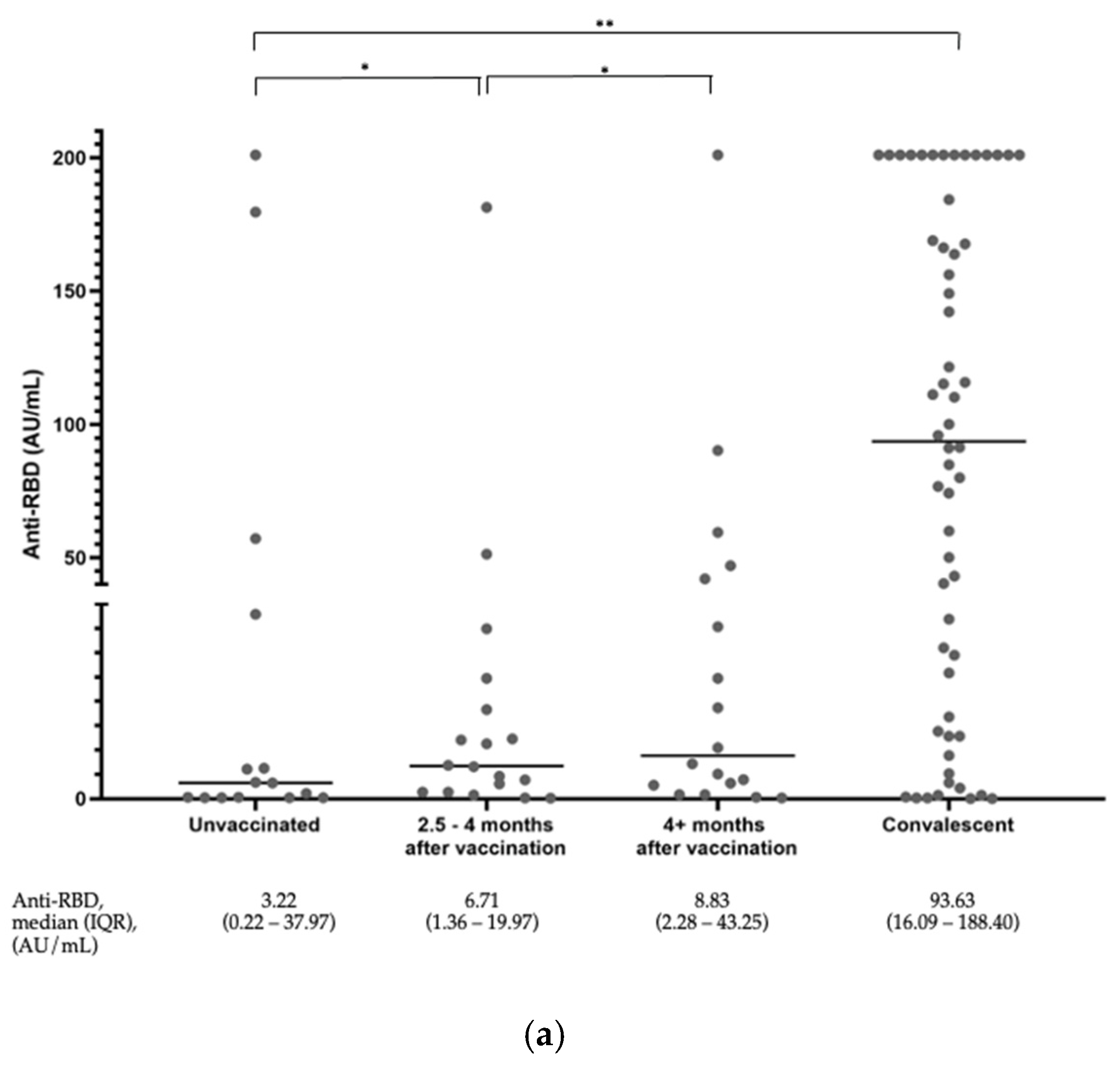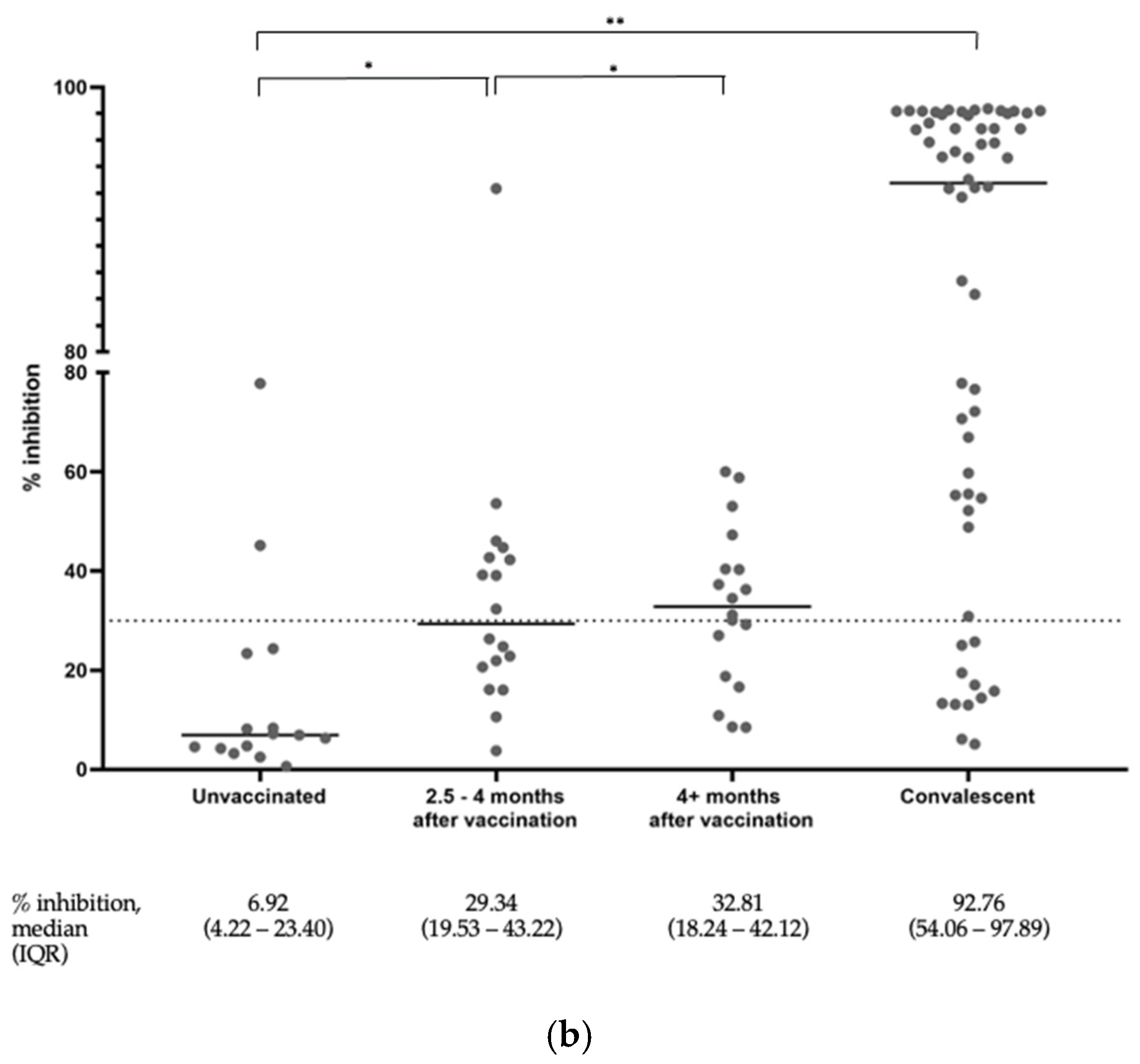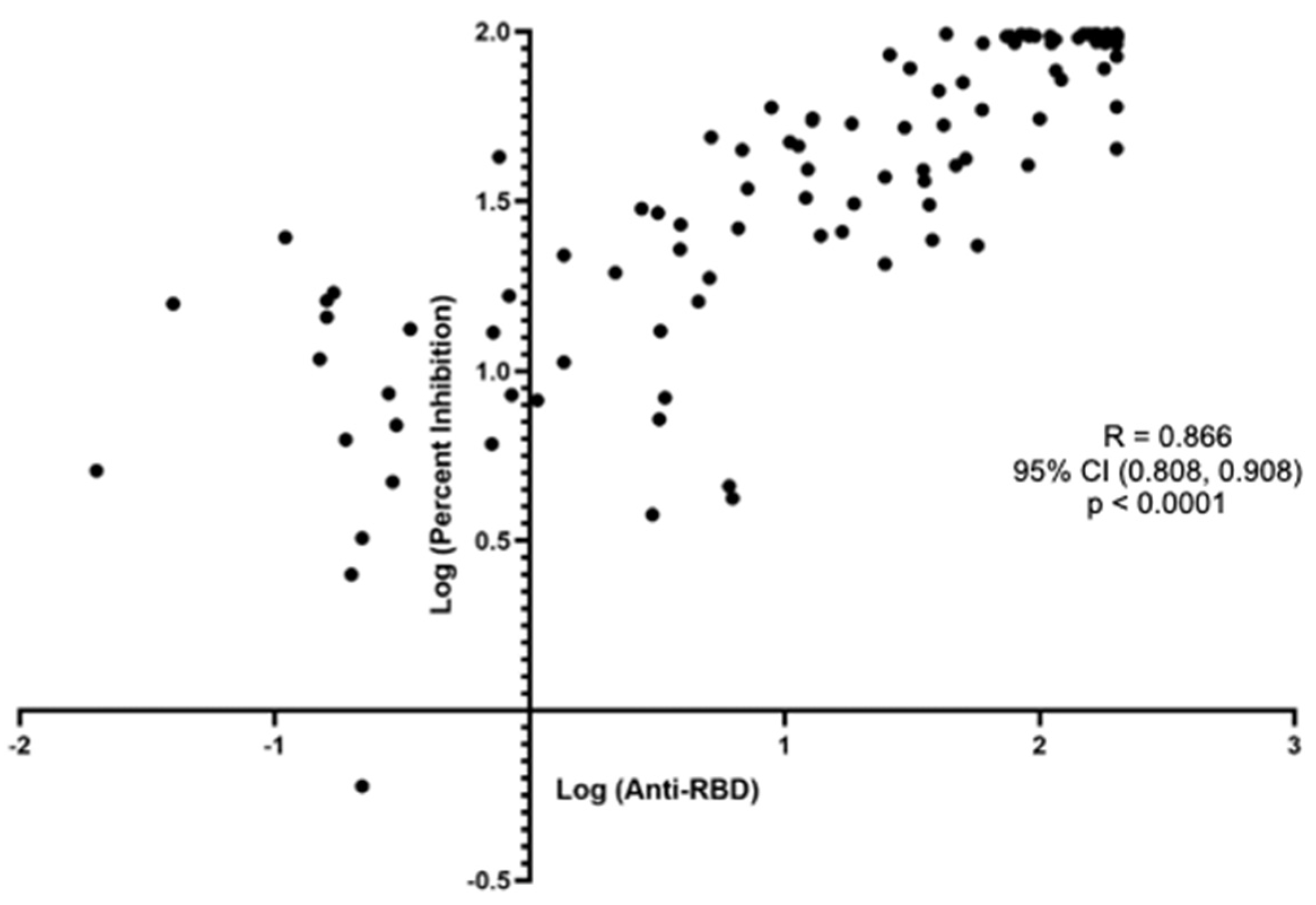Performance of a Point-of-Care Fluorescence Immunoassay Test to Measure the Anti-Severe Acute Respiratory Syndrome Corona Virus 2 Spike, Receptor Binding Domain Antibody Level
Abstract
:1. Introduction
2. Materials and Methods
2.1. Study Design
2.2. Data Collected
2.3. Ethical Clearance
2.4. Reference Test: GenScript cPass SARS-CoV-2 Neutralization Antibody Detection Kit
2.5. Test Being Validated: FastBio-RBD—SARS-CoV-2 Antibody Test
2.6. Statistical Analysis
3. Results
3.1. Study Sample
3.2. Anti-S-RBD Titer of Convalescent Subjects and Vaccinees without a COVID-19 History Measured Using FastBio-RBD
3.3. Percentage Inhibition of the Convalescent Subjects and Vaccinees without a COVID-19 History Measured Using the SVNT
3.4. Correlation between the Anti-S-RBD Titer and Percentage Inhibition
3.5. Accuracy of the FastBio-RBD vs. SVNT
4. Discussion
5. Conclusions
Author Contributions
Funding
Institutional Review Board Statement
Informed Consent Statement
Data Availability Statement
Acknowledgments
Conflicts of Interest
References
- WHO. WHO Director-General’s Opening Remarks at the Media Briefing on COVID-19. Available online: https://www.who.int/director-general/speeches/detail/who-director-general-s-opening-remarks-at-the-media-briefing-on-covid-19---11-march-2020 (accessed on 13 September 2023).
- De Gier, B.; van Asten, L.; Boere, T.M.; van Roon, A.; van Roekel, C.; Pijpers, J.; van Werkhoven, C.H.H.; van den Ende, C.; Hahne, S.J.M.; de Melker, H.E.; et al. Effect of COVID-19 vaccination on mortality by COVID-19 and on mortality by other causes, the Netherlands, January 2021–January 2022. Vaccine 2023, 41, 4488–4496. [Google Scholar] [CrossRef] [PubMed]
- Sharif, N.; Alzahrani, K.J.; Ahmed, S.N.; Dey, S.K. Efficacy, immunogenicity and safety of COVID-19 vaccines: A systematic review and meta-analysis. Front. Immunol. 2021, 12, 714170. [Google Scholar] [CrossRef] [PubMed]
- Zimmermann, P.; Curtis, N. Factors that influence the immune response to vaccination. Clin. Microbiol. Rev. 2019, 32, e00084-18. [Google Scholar] [CrossRef] [PubMed]
- Uysal, E.B.; Gumus, S.; Bektore, B.; Bozkurt, H.; Gozalan, A. Evaluation of antibody response after COVID-19 vaccination of healthcare workers. J. Med. Virol. 2022, 94, 1060–1066. [Google Scholar] [CrossRef] [PubMed]
- Mushtaq, S.; Azam Khan, M.K.; Alam Khan, M.Q.; Rathore, M.A.; Parveen, B.; Noor, M.; Ghani, E.; Tahir, A.B.; Tipu, H.N.; Lin, B. Comparison of immune response to SARS-CoV-2 vaccine in COVID-recovered versus non-infected Individuals. Clin. Exp. Med. 2023, 23, 2267–2273. [Google Scholar] [CrossRef] [PubMed]
- Valcourt, E.J.; Manguiat, K.; Robinson, A.; Chen, J.C.; Dimitrova, K.; Philipson, C.; Lamoureux, L.; McLachlan, E.; Schiffman, Z.; Drebot, M.A.; et al. Evaluation of a commercially-available surrogate virus neutralization test for severe acute respiratory syndrome coronavirus-2 (SARS-CoV-2). Diagn. Microbiol. Infect. Dis. 2021, 99, 115294. [Google Scholar] [CrossRef] [PubMed]
- Lu, Y.; Wang, J.; Li, Q.; Hu, H.; Lu, J.; Che, Z. Advances in Neutralization Assays for SARS-CoV-2. Scand. J. Immunol. 2021, 94, e13088. [Google Scholar] [CrossRef]
- Hofmann, N.; Grossegesse, M.; Neumann, M.; Schaade, L.; Nitsche, A. Evaluation of a commercial ELISA as alternative to plaque reduction neutralization test to detect neutralizing antibodies against SARS-CoV-2. Sci. Rep. 2022, 12, 3549. [Google Scholar] [CrossRef] [PubMed]
- Koczula, K.M.; Gallotta, A. Lateral flow assays. Essays Biochem. 2016, 60, 111–120. [Google Scholar] [CrossRef] [PubMed]
- Ozinskas, A.J. Principles of Fluorescence Immunoassay. In Topics in Fluorescence Spectroscopy; Lakowicz, J.R., Ed.; Springer: Boston, MA, USA, 2002; Volume 4, pp. 449–496. [Google Scholar]
- Wondfo. Finecare—FIA Meter Plus (FS-113); Wondfo: Guangzhou, China, 2023. [Google Scholar]
- Iyer, A.S.; Jones, F.K.; Nodoushani, A.; Kelly, M.; Becker, M.; Slater, D.; Millsa, R.; Teng, E.; Kamruzzaman, M.; Garcia-Beltran, W.F.; et al. Persistence and decay of human antibody responses to the receptor binding domain of SARS-CoV-2 spike protein in COVID-19 patients. Sci. Immunol. 2020, 5, eabe0367. [Google Scholar] [CrossRef] [PubMed]
- GenScript. cPass SARS-CoV-2 Neutralization Antibody Detection Kit Instruction for Use; GenScript: Piscataway, NJ, USA, 2022. [Google Scholar]
- Wondfo Biotech Co., Ltd. The Finecare 2019-nCoV RBD Antibody Test; Wondfo: Guangzhou, China, 2021. [Google Scholar]
- Taylor, S.C. A practical approach to SARS-CoV-2 testing in a pre and post-vaccination era. J. Clin. Virol. Plus 2021, 1, 100044. [Google Scholar] [CrossRef] [PubMed]
- Lee, H.J.; Jung, J.; Lee, J.H.; Lee, D.G.; Kim, Y.B.; Oh, E.J. Comparison of Six Serological Immunoassays for the Detection of SARS-CoV-2 Neutralizing Antibody Levels in the Vaccinated Population. Viruses 2022, 14, 946. [Google Scholar] [CrossRef] [PubMed]
- Muslimah, A.H.; Tiara, M.R.; Djauhari, H.; Dewantara, M.H.; Susandi, E.; Indrati, A.R.; Alisjahbana, B.; Soeroto, A.Y.; Wisaksana, R. High Levels of Anti-SARS-CoV-2 Receptor-Binding Domain (RBD) Antibodies One Year Post Booster Vaccinations among Hospital Workers in Indonesia: Was the Second Booster Needed? Vaccines 2023, 11, 1300. [Google Scholar] [CrossRef] [PubMed]
- Glück, V.; Tydykov, L.; Mader, A.L.; Warda, A.S.; Bertok, M.; Weidlich, T.; Gottwald, C.; Köstler, J.; Salzberger, B.; Wagner, R.; et al. Humoral immunity in dually vaccinated SARS-CoV-2-naïve individuals and in booster-vaccinated COVID-19-convalescent subjects. Infection 2022, 50, 1475–1481. [Google Scholar] [CrossRef] [PubMed]
- Fonseca, M.H.G.; Souza, T.d.F.G.d.; Araújo, F.M.d.C.; Andrade, L.O.M.d. Dynamics of antibody response to CoronaVac vaccine. J. Med. Virol. 2022, 94, 2139–2148. [Google Scholar] [CrossRef] [PubMed]
- Yun, S.; Ryu, J.H.; Jang, J.H.; Bae, H.; Yoo, S.-H.; Choi, A.-R.; Jo, S.J.; Lim, J.; Lee, J.; Ryu, H.; et al. Comparison of SARS-CoV-2 antibody responses and seroconversion in COVID-19 patients using twelve commercial immunoassays. Ann. Lab. Med. 2021, 41, 577–587. [Google Scholar] [CrossRef] [PubMed]
- Hasugian, A.R.; Khariri. Laboratory examination to measure antibodies formed after vaccination of COVID-19. IOP Conf. Ser. Earth Environ. Sci. 2021, 824, 012073. [Google Scholar] [CrossRef]
- Zedan, H.T.; Yassine, H.M.; Al-Sadeq, D.W.; Liu, N.; Qotba, H.; Nicolai, E.; Pieri, M.; Bernardini, S.; Abu-Raddad, L.J.; Nasrallah, G.K. Evaluation of commercially available fully automated and ELISA-based assays for detecting anti-SARS-CoV-2 neutralizing antibodies. Sci. Rep. 2022, 12, 19020. [Google Scholar] [CrossRef] [PubMed]



| Characteristics | Without a History of COVID-19 (N = 51) | Convalescent Subjects (N = 58) |
|---|---|---|
| Sex, n (%) Male Female | 24 (47.1) 27 (52.9) | 31 (53.4) 27 (46.6) |
| Age, (years) | ||
| 18–29 | 15 (29.4) | 14 (24.1) |
| 30–39 | 15 (29.4) | 17 (29.3) |
| 40–49 | 8 (15.7) | 13 (22.4) |
| 50–59 | 3 (5.9) | 6 (10.3) |
| ≥60 | 10 (19.6) | 8 (13.8) |
| Comorbidity, n (%) | ||
| No comorbidity | 39 (76.4) | 43 (74.1) |
| Yes | 12 (23.6) | 15 (25.9) |
| Hypertension | 8 (15.7) | 3 (5.2) |
| Diabetes mellitus | 1 (2.0) | 4 (6.9) |
| Cardiovascular disease | 2 (3.9) | 2 (3.4) |
| Chronic lung disease | 0 (0) | 5 (8.6) |
| Others | 1 (2.0) | 1 (1.7) |
| Among subjects without a history of COVID, n (%) | ||
| No vaccination | 15 (29.4) | 28 (48.3) |
| Vaccinated | 36 (70.6) | 30 (51.7) |
| Time interval between COVID-19 Vaccination and testing n (%) | ||
| 2.5–4 months | 18 (35.3%) | n.a. |
| ≥4 months | 18 (35.3%) | n.a. |
| Among subjects with a history of COVID-19 | ||
| Time interval between test and COVID-19, n (%) | ||
| <1 month | n.a. | 14 (24.1) |
| 1–2 months | n.a. | 26 (44.8) |
| 2–3 months | n.a. | 8 (13.8) |
| >3 months | n.a. | 10 (17.2) |
| % Inhibition ≥30% | % Inhibition <30% | Accuracy | |
| Anti-S-RBD ≥ 6.71 AU/mL (134.2 BAU/mL) | 66 | 5 | Sensitivity 95.7% Specificity 87.5% |
| Anti-S-RBD < 6.71 AU/mL (134.2 BAU/mL) | 3 | 35 | Positive predictive value 93.0% Negative predictive value 92.1% |
| % Inhibition ≥60% | % Inhibition <60% | Accuracy | |
| Anti-S-RBD ≥ 59.76 AU/mL (1.195.2 BAU/mL) | 37 | 2 | Sensitivity 88.1% Specificity 97.0% |
| Anti-S-RBD < 59.76 AU/mL (1.195.2 BAU/mL) | 5 | 65 | Positive predictive value 94.9% Negative predictive value 92.9% |
| Advantages | Disadvantages | |
|---|---|---|
| FastBio-RBDTM (fluorescence immunoassay) |
|
|
| GenScript-cPASSTM (SVNT) |
|
|
Disclaimer/Publisher’s Note: The statements, opinions and data contained in all publications are solely those of the individual author(s) and contributor(s) and not of MDPI and/or the editor(s). MDPI and/or the editor(s) disclaim responsibility for any injury to people or property resulting from any ideas, methods, instructions or products referred to in the content. |
© 2023 by the authors. Licensee MDPI, Basel, Switzerland. This article is an open access article distributed under the terms and conditions of the Creative Commons Attribution (CC BY) license (https://creativecommons.org/licenses/by/4.0/).
Share and Cite
Tiara, M.R.; Djauhari, H.; Rachman, F.R.; Rettob, A.C.; Utami, D.; Pulungan, F.C.S.; Purwanta, H.; Wisaksana, R.; Alisjahbana, B.; Indrati, A.R. Performance of a Point-of-Care Fluorescence Immunoassay Test to Measure the Anti-Severe Acute Respiratory Syndrome Corona Virus 2 Spike, Receptor Binding Domain Antibody Level. Diagnostics 2023, 13, 3686. https://doi.org/10.3390/diagnostics13243686
Tiara MR, Djauhari H, Rachman FR, Rettob AC, Utami D, Pulungan FCS, Purwanta H, Wisaksana R, Alisjahbana B, Indrati AR. Performance of a Point-of-Care Fluorescence Immunoassay Test to Measure the Anti-Severe Acute Respiratory Syndrome Corona Virus 2 Spike, Receptor Binding Domain Antibody Level. Diagnostics. 2023; 13(24):3686. https://doi.org/10.3390/diagnostics13243686
Chicago/Turabian StyleTiara, Marita Restie, Hofiya Djauhari, Febi Ramdhani Rachman, Antonius Christianus Rettob, Darmastuti Utami, Fahda Cintia Suci Pulungan, Heru Purwanta, Rudi Wisaksana, Bachti Alisjahbana, and Agnes Rengga Indrati. 2023. "Performance of a Point-of-Care Fluorescence Immunoassay Test to Measure the Anti-Severe Acute Respiratory Syndrome Corona Virus 2 Spike, Receptor Binding Domain Antibody Level" Diagnostics 13, no. 24: 3686. https://doi.org/10.3390/diagnostics13243686
APA StyleTiara, M. R., Djauhari, H., Rachman, F. R., Rettob, A. C., Utami, D., Pulungan, F. C. S., Purwanta, H., Wisaksana, R., Alisjahbana, B., & Indrati, A. R. (2023). Performance of a Point-of-Care Fluorescence Immunoassay Test to Measure the Anti-Severe Acute Respiratory Syndrome Corona Virus 2 Spike, Receptor Binding Domain Antibody Level. Diagnostics, 13(24), 3686. https://doi.org/10.3390/diagnostics13243686






